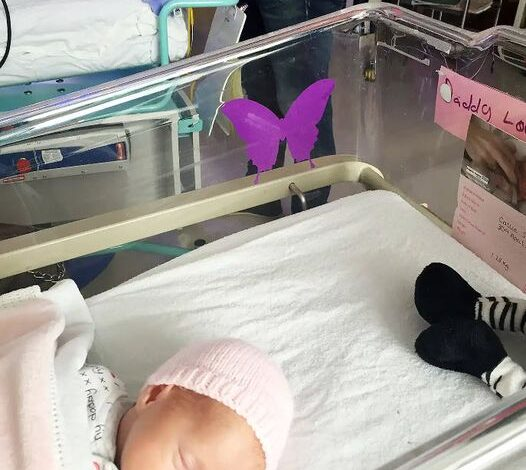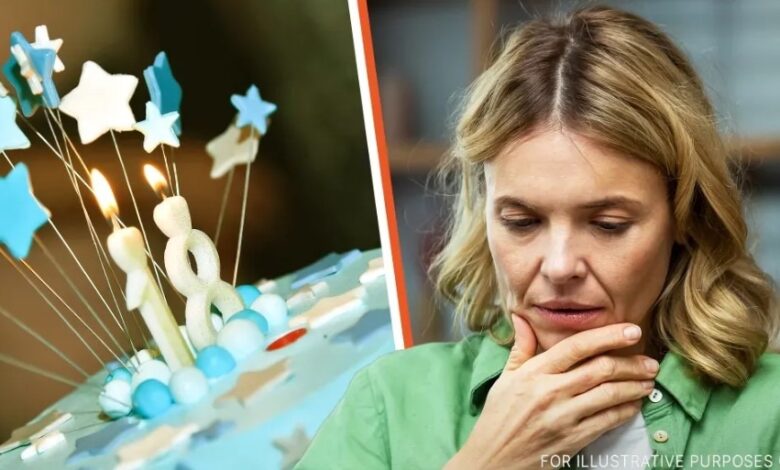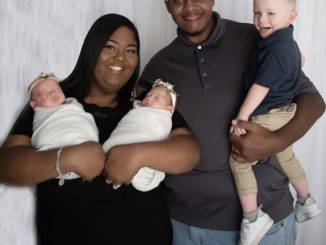
Only weeks after Millie Smith and Lewis Cann learned they were having twin baby girls, they learned that only one would survive.
On April 30, after 30 weeks of a high-risk pregnancy, Smith delivered identical twins, Callie and Skye, the latter who lived only three hours.
Later in neonatal intensive care unit (NICU), Callie slept without her sister in the incubator, with her loving and grieving parents watching over her. In the unit with other babies, an overwhelmed mom of healthy newborn twins innocently told Smith that she was “so lucky” to not have two babies.
Crushed by the words, the new mom couldn’t find the words to explain her loss. Then, she realized that Skye’s legacy was to help other families who lose a child, and it came in the form of a purple butterfly.
In November 2015 Millie Smith and partner Lewis Cann found out they were having their first Child. Smith, who has twins in the family, said she had a “gut feeling” about having a duo and 10 weeks later, doctors confirmed she was expecting identical twin girls.
Less than two weeks after the excitement of knowing they would double the children in their home, the British couple were devastated to learn that one of their babies had a fatal condition and wouldn’t survive after birth.
“During the scan, the doctor didn’t say anything. I was very excited and loved seeing the little babies, but she was silent. Both Lewis and I immediately knew there must be a problem,” Smith said.
Doctors shared the news that one of the babies had anencephaly, which according to the Centers for Disease Control and Prevention (CDC) affects about one in 4,600 babies across the U.S. It’s a serious birth defect where a baby is born without parts of the brain and skull, and “almost all babies born with anencephaly will die shortly after birth.”
Knowing that one baby would die soon after birth, and that there were risks involved for their other baby, the couple decided to move forward with the extremely high-risk pregnancy.
Over the next several months, Smith and Cann named their twins Skye and Callie. “We knew that Skye needed to have a name before she was born,” Smith said. “Knowing she would only survive for seconds or minutes, I wanted her to be named during that time.”
The meaning behind “Skye,” she explained “was somewhere we knew she would always be, that we could look up at the sky and remember our baby.”
When Smith went into labor after only 30 weeks on April 30, she needed an emergency C-section. To help navigate the loss, the couple had a “bereavement midwife” during the birth, and they were put I a special room the called the “Daisy Room,” where families can spend time with a baby before and after she/he passes.
“When the girls were born, they both cried. This was a huge moment, as we were told that Skye would not make a noise or move,” said Smith, who was thankful to have three hours with Skye before she died. “We were cuddling Skye when she passed away. This was the worst moment in our lives. I have never ever felt heartbreak like that before. But I am proud that she fought for so long to spend time with us.”
Born premature, Callie had to stay in NICU while she gained some strength and also in the unit were three other sets of twin.
“Most of the nurses were aware of what had happened, but as time passed, people stopped talking about Skye. After about four weeks, everyone acted as though nothing had happened, meaning the families around me had no idea about our situation,” Smith recalled.
One morning, a stressed mother whose twins were also in NICU, harmlessly said to Smith that she was “so lucky” to not have twins.
“None of the other parents knew what had happened or anything about Skye. The comment was completely innocent and more out of humor…They weren’t to know that I did at one point have two.” Smith continued, “But the comment nearly broke me. I ran out [of] the room in tears and they had no idea why. I didn’t have the heart to tell them what had happened. A simple sticker would have avoided that entire situation.”
It was in that moment Smith realized she had to create something that would speak for parents who had just lost a baby, ensuring the misunderstanding never happens again.
She designed a poster for the NICU explaining both hospital personnel and visitors that any incubator with a purple butterfly on it means that one or more babies, in a set of multiples were lost.
“I chose butterflies, as I felt it was fitting to remember the babies that flew away, the color purple because it is suitable for both boys or girls,” said Smith.
The purple butterfly concept–now under the Skye High Foundation–has spread to hospitals in several countries around the world.
Callie is now a lively, happy seven-year-old, and twin’s memory lives in purple butterfly cards along with other initiatives to help families with babies like Skye all over the world. The purple butterflies now come in numerous forms, like ornaments, cards, blankets, stuffed animals and more.
“Ultimately I will never be able to stop this from happening but the more support groups we can set up and put things in place like the stickers the better it will be. It’s the hardest thing anyone has to deal with,” Smith said.
The 18th Birthday Surprise I Planned for My Stepmom Turned Her World Upside Down

My 18th birthday was a day I’ll never forget, not just because it marked my official transition into adulthood, but because it was the day I planned to reveal a surprise for my stepmom — one that I hoped would change her life in a way she never saw coming.
Have you ever felt like life is one long, unscripted drama, where every scene holds the potential to either break you or forge you into something stronger?
My life’s been a bit like that.
Navigating through the choppy waters of loss and new beginnings, I found myself at the helm of a decision that could either be the most heartwarming episode or a plot twist gone wrong.
My name is Sarah and this is the story of how my entry into adulthood became unforgettable for the most surprising reason.
After my mom passed away when I was just 11, life felt like an endless storm. My dad, lost in his own sea of grief, found a beacon of hope in a new woman and eventually remarried.
That’s how my stepmom, Olivia, came into my life, and she would become much more than just a new face in the house. She became a great source of stability for me, always offering love and support when I needed it.
At first, though, I wasn’t ready for her. I was too angry, too wrapped up in my grief to see her for who she was. I remember the day she moved in — I stayed locked in my room, listening to the muffled sounds of her unpacking, refusing to acknowledge that she was now a part of our lives.
I thought, How could my dad move on so quickly? How could he bring someone new into our home?
But contrary to my fears, Olivia never forced her way in. She gave me space, patiently waiting until I was ready to talk. And when I finally did, she was there, listening without judgment. One night, I had a nightmare about my mom. I woke up sobbing, drenched in sweat. Olivia heard me from the hallway and quietly opened my door.
“Sarah, sweetie, it’s okay. You’re safe,” she whispered as she sat beside me, her hand gently rubbing my back. I didn’t push her away. For the first time, I let her comfort me, and as she held me, I felt a small sliver of warmth amid the grief.
And just like that, Olivia and I became close. She never tried to take my mom’s place but filled our home with a light I thought we’d lost forever. “I’m here for you, always,” she’d tell me, her words a soothing balm for my aching heart.
But life had another curveball waiting. When we lost my dad, the silence in our home was deafening. I remember us sitting in the dimly lit living room, the air heavy with fear and uncertainty.
“I can’t imagine how hard this is for you,” she said, her voice barely above a whisper. “But I want you to know, I’m here for you. We’re family, no matter what.”
Her words were a lifeline in my sea of despair. “But everyone’s saying you’ll leave… go back to your family,” I mumbled, struggling to hold back tears. “Will I…will I go to an orphanage?”
It wasn’t just my fear of losing her. I’d overheard people whispering at the funeral: speculations about how Olivia would pack up and leave, how she had no reason to stay now that my dad was gone. The idea terrified me. I didn’t want to be alone again.
“No, sweetie. You’re not going anywhere and neither am I. Look at me,” she said, her hand finding mine in the darkness. She then cupped my face, planting a tender kiss on my forehead. “We’ll get through this together.”
For a moment, the heaviness in my chest lifted. Olivia’s presence had always been steady, like an anchor in the storm. She stayed by my side through every awkward family gathering where people looked at us with pity and through every sleepless night where grief threatened to swallow me whole. And slowly, I began to trust that she meant it when she said she wasn’t going anywhere.
And she was right. Despite the whispers and sideways glances from others, she stayed, proving that the bonds of the family we choose are as strong as those we are born into.
On the morning of my 18th birthday, the air was thick with anticipation, not just for the usual celebrations but for a surprise I had been planning for years.
Olivia greeted me with her warm, comforting smile, one that had often brightened my mood since the day she stepped into our lives.
“Happy birthday, sweetheart,” she said, handing me a small, beautifully wrapped box. Her eyes sparkled with the love and care that had become her trademark.
I took the box, my hands shaking slightly. I wasn’t nervous about the gift inside — it was the gift I had for her that had my heart racing.
“Thank you,” I replied, my heart swelling with gratitude for this woman who had chosen to stand by me through everything. “I have a surprise for you too, but… you’ll need to pack your things.”
The look of confusion on her face was immediate. “Pack my things?” she echoed, the joy of the moment fading into uncertainty. “Are you… Are you serious?”
“Yes,” I said, my voice steady despite the turmoil inside. “I want you to pack your things in the next hour. You’re leaving this house.”
Her laughter, light and disbelieving at first, died down as she saw the seriousness in my eyes. “But why, dear? I thought we were a family…” Her voice trailed off, a hint of despair creeping in.
I could feel my resolve wavering. The way her voice cracked, the pain in her eyes — it was more than I had anticipated. But I couldn’t back down. Not now. Not yet.
“It’s time,” I began, the weight of the moment pressing down on me. “I’ve been planning this since the day Dad died. You are going to another city.”
She sat down at the kitchen table, her hands shaking as she reached for something to steady herself, but her fingers grasped at nothing. Her breath hitched as she whispered, “I don’t understand. What did I do? Why are you sending me away?”
In a moment that felt more like a scene from a movie, I loaded her sparse belongings into the car and drove her to a new destination, all while she sat beside me in a silence that was heavy with confusion and sorrow.
The drive was a long and silent one, filled with unspoken questions and tension. I was the first to talk.
“You didn’t know that my father opened an account in my name when I was a child, where he saved money for my education. Since his death, I’ve also put all my money, from my part-time jobs and gifts, into this account. Now, there’s a large sum.”
Olivia turned to me, a mixture of pain and understanding in her eyes. “I understand. You’re an adult now, you have money and you don’t need me anymore. But why are you sending me so far away? You don’t want to see me at all?”
Her voice cracked, and the words felt like daggers in my chest. I had never imagined this moment would hurt so much.
As we pulled up in front of a quaint, beautiful house, the surprise I had been harboring was finally ready to be unveiled.
“I will be spending some of this money on education,” I continued, pointing to the house. “At an Ivy League university in the city, we’re in now, where I have already been accepted. Do you see this house?”
“Yes,” she whispered, her voice laden with confusion and a trace of hope.
“I bought this house for you,” I revealed, the tension finally breaking. “There was enough money for everything. Now I will study here and you will live next door. We won’t have to be apart, and if you want, you can go back to our old house at any time, or we can return together after I finish my studies.”
She sat in stunned silence for a long moment, her eyes locked on the house. “You… you bought this for me?” she whispered, her voice shaking.
The tears came then, unbidden and free, marking the moment with an emotional intensity that words could hardly capture. We hugged, our tears mingling, a testament to the depth of our bond and the love that had grown between us over the years.
“I love you, Sarah,” said Olivia, her voice barely a whisper but still audible.
“I love you, too,” I replied, reaching for the house keys in my bag and placing them in her hand.
It was a birthday unlike any other, marked not just by the receiving of gifts, but by the giving of a future, a home, and a promise of continued family, no matter what life might bring.
This was our story, a stepdaughter and her stepmom, navigating the complexities of life together, proving that love, indeed, knows no bounds.
As we stood there, holding onto each other in front of her new home, I felt a wave of relief wash over me. I had done it: I had given back to the woman who had given me so much.
For the first time in years, I felt like I could truly breathe, knowing that we had a future, together.
Do you think my surprise was a good one?



Leave a Reply